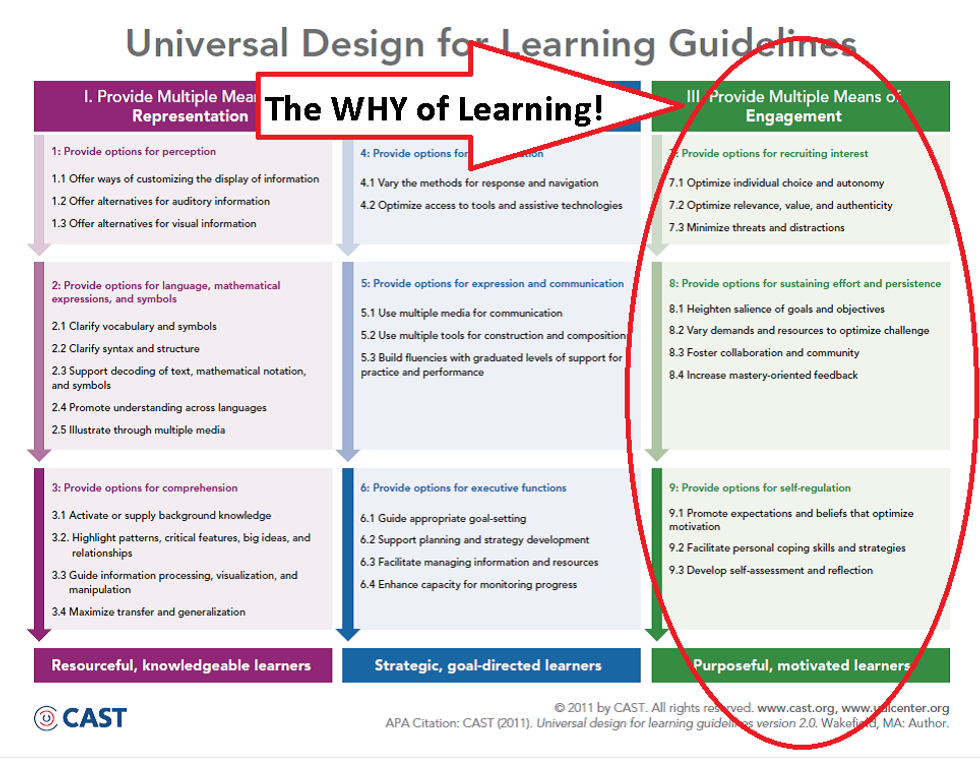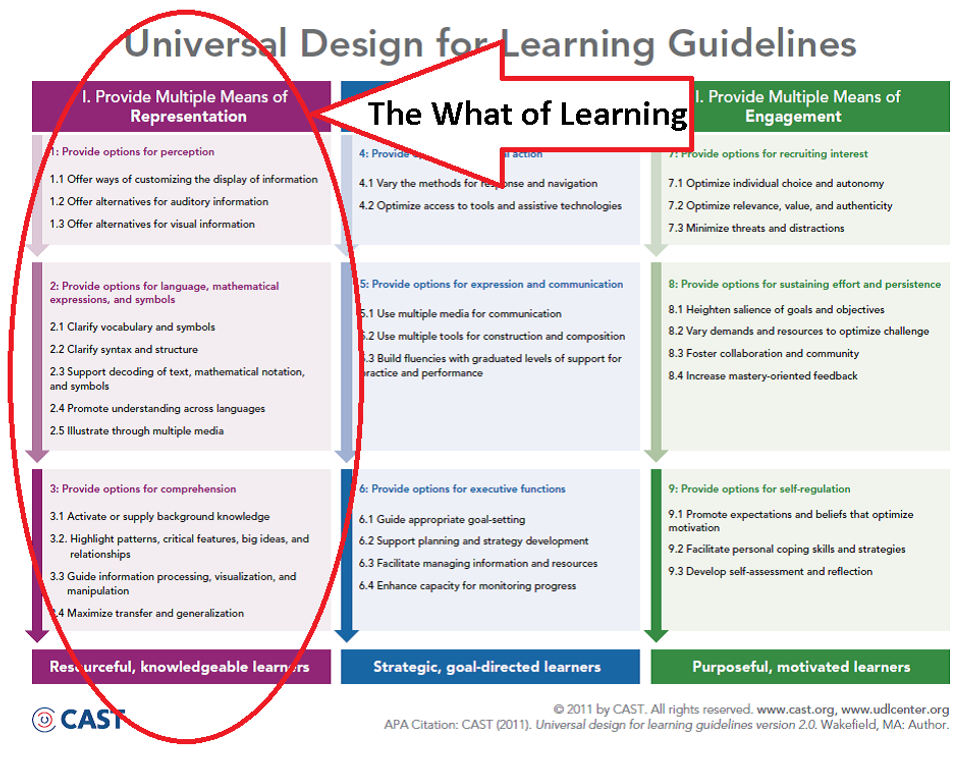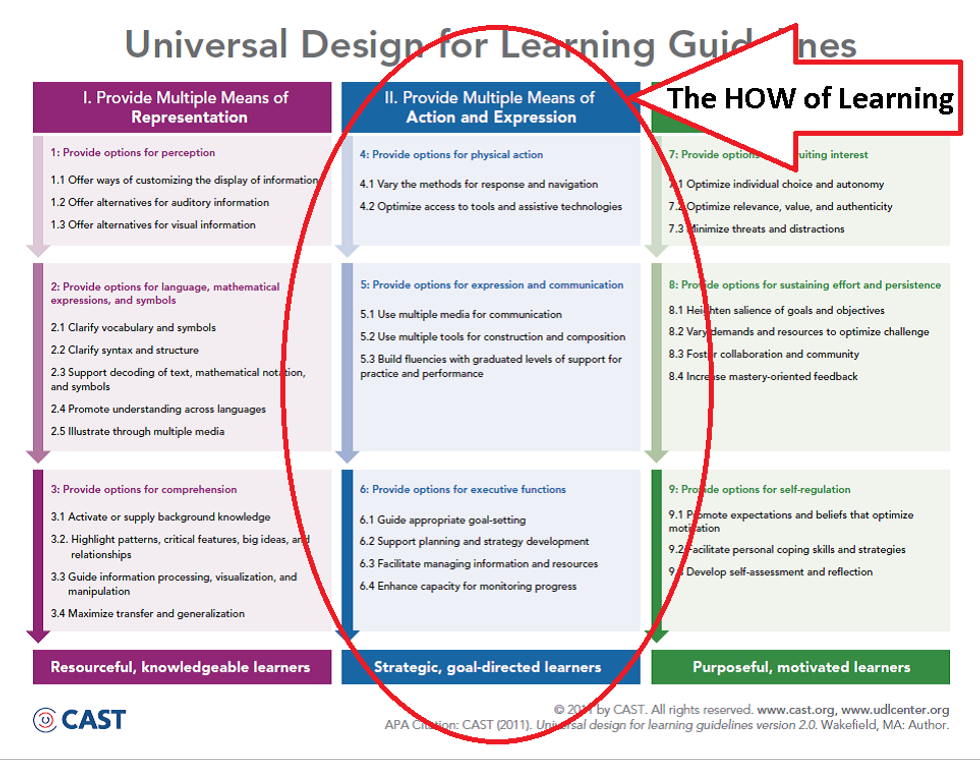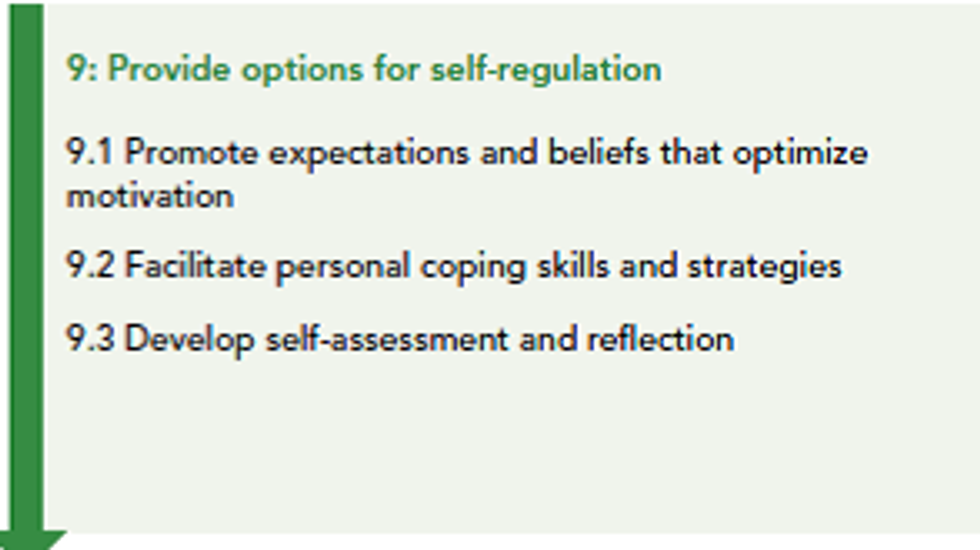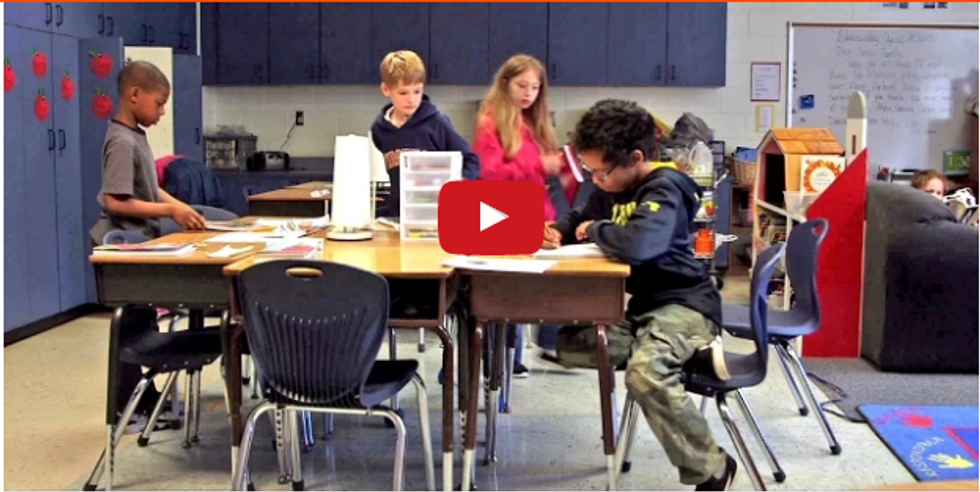We are ready to wrap up our deeper dive into Universal Design for Learning and the subsequent nine guidelines. As our acute look at each guideline comes to a close, we finish by examining guideline nine 9: options for self-regulation as part of the Affective Network of the brain, also known as the principle of Engagement or the WHY of learning.
For more information on the preceding guidelines associated with the affective network of the brain or the Why of learning see:
Guideline 7: options for recruiting interest: Universal Design for Learning: Deeper Dive 7
Guideline 8: options for sustaining effort and persistence: Universal Design for Learning: Deeper Dive 8
For more information on the preceding guidelines associated with the recognition network of the brain or the What of learning see:
Guideline 1: options for perception: Universal Design for Learning: Taking a Deeper Dive
Guideline 2: options for language, mathematical expressions, and symbols: Universal Design for Learning: Taking a Deeper Dive 2
Guideline 3: options for comprehension: Universal Design for Learning: Deeper Dive 3
For more information on the guidelines associated with the strategic network of the brain or the How of learning see:
Guideline 4: options for physical action Universal Design for Learning: Deeper Dive 4
Guideline 5: options for expression and communication Universal Design for Learning: Deeper Dive 5
Guideline 6: options for executive functions Universal Design for Learning: Deeper Dive 6
Quick Recap about UDL: Starting with the base knowledge that Universal Design for Learning (UDL) is a framework for designing and delivering instruction based on the three networks of the brain associated with learning:
1. The Recognition Network or the What of learning
2. The Strategic Network or the How of learning
3. The Affective Network or the Why of learning (CAST 20012)
The three broad networks support the three principles of UDL (I) Provide multiple means of representation; (II) provide multiple means of action and expression; and (III) provide multiple means of engagement” (Rose & Meyer, 2002) and the subsequent nine guidelines.
We are going to move to our last guideline! Guideline 9: options for self-regulation falls under the principle of Engagement or the WHY of learning. While the last for us to cover, it certainly is not least. This guideline informs us on how to support students with opportunities to "demonstrate their highest level of independence" (Lord Nelson p. 44). Here we truly begin to understand the major purpose: "students recognize themselves as learner and how to facilitate their ow learning" (Lord Nelson p. 44). Let's zero in on it!
What: Another way to define options for self-regulation is simply options to set goals and self regulate. What does that really mean for a student? The ability to regulate emotion and motivations to:
-Deal with frustration
-Avoid anxiety
-Manage and direct emotional responses to external events
-Manage and direct emotional responses to internal events
-Accurately monitor emotions
-Recognize progress
Part of the what for self-regulation is also understanding "what" the goal is. For this network of the brain and this guideline specifically we are are attending to providing strategies, options, and support that allows students to learn how to be purposeful and motivated.
Considering "what" possible barriers exist in the learning environment and "what" variabilities are represented by the students should be considered as well.
Additionally, Lord Nelson (2014) suggests that the process of supporting and guiding students in the development of self-regulation when both self-monitoring and self-reflecting can begin at a very young age. However, "no matter the age, most students need structure to help them achieve in this area" (Lord Nelson p. 45).
How: When designing and creating your learning environment some questions to ask are:
-Have I provided checklists and rubrics to be self-reflective?
-What skills must my students learn to develop internal controls and coping skills?
-How can I teach students to collect data on their behaviors to motivate themselves?
It is also important to note that behavior expectations and self-monitoring tools work most realistically and effectively in a classroom culture that promotes equity of voice, trust, respect, and responsibility. A systems approach that enhances this culture could be PBIS or Positive Behaviour Instructional Supports. It is important to note and highlight the "instructional" notation here because proactive approaches versus student deficit models place the burden on the environment and instructional practices instead of reactionarily on the student.Other ways to promote and support this guideline is to simply teach it and be transparent about what it means, looks like, and how it can be supported. For example, Novak suggests telling students "throughout the year I will teach you different strategies that will help you complete your work even when it seems really hard and you would rather give up" (p. 43). So when supporting students in setting goals, one support can be to demonstrate and assist them with setting realistic goals.
When attending to self-reflection and assessment, Lord Nelson (2014) suggests having students reflect on who they are as a learner in the context of the learning environment. Whether writing or journaling, utilizing a rubric, emojis, or placing themselves on a mood meter, it is important to build opportunities into the learning environment on a daily basis as well as periodically throughout the day when needed.
Why: We previously noted affective networks “monitor the internal and external environment to set priorities, to motivate, and to engage learning and behavior” (Meyer, Rose, & Gordon p.54). The affective network further impacts both the "emotional and motivational significance of the world around us" (Meyer, Rose, & Godon p. 65) or more acutely for a student, their classroom or learning environment. Hammond (2015) suggests there are 6 core principles to bear in mind in understanding how the "brain uses culture to interpret threats and opportunities (p. 46). Five of the six can be directly reflected in the guidelines associated with the affective network of the brain. The outlier ties directly to the recognition network and guidelines 2 and 3.
1. The brain seeks to minimize social threat and maximize opportunities to connect with others in community.
2. Positive relationships keep our safety-threat detection system in check.
3. Culture guides how we process information.
4. Attention drives learning.
5. All new information must be coupled with existing funds of knowledge in order to be learned.
6. The brain physically grows through challenge and stretch, expanding its ability to do more complex thinking and learning.
And remember, something as simple as "choice and voice" in where a student learns best in the environment is powerful and empowering to a sense of belonging and self-regulating.
CAST, Inc. (2012) Retrieved from: http://www.udlcenter.org/aboutudl/whatisudl
Hammond, Zaretta. (2015) Culturally Responsive Teaching and the Brain. Thousand Oaks, CA: Corwin.
Lord Nelson, Loui. (2014) Design and Deliver: Planning and Teaching Using Universal Design for Learning. Baltimore, MD: Brookes Publishing.
Meyer, A., Rose, H. D., Gordon, D. (2014). Universal Design for Learning, theory and practice. Wakefield, MA: CAST Professional Publishing.
Novak, Katie. (2014)) UDL Now. Wakefield, MA: CAST Publishing.




